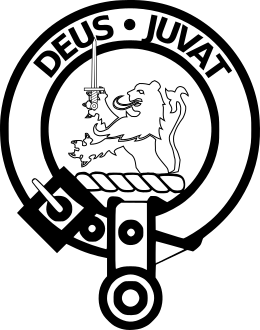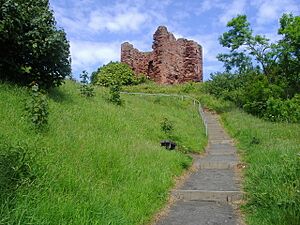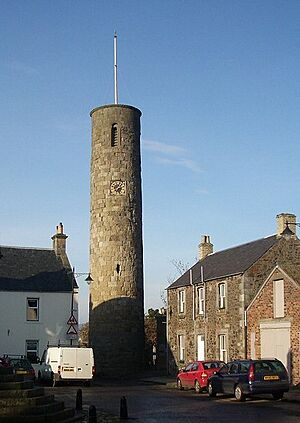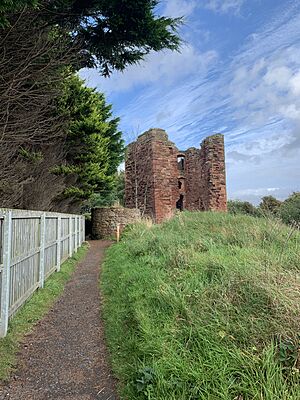Clan MacDuff facts for kids
Quick facts for kids Clan MacDuff |
|||
|---|---|---|---|
| MacDhuibh | |||
 |
|||
| Motto | Deus juvat (Latin for 'God assists') | ||
| Profile | |||
| Plant badge | Red whortleberry (lingonberry), or boxwood | ||
| Pipe music | MacDuff's Lament | ||
 |
|||
| Clan MacDuff has no chief, and is an armigerous clan | |||
| Historic seat | Macduff's Castle | ||
| Last Chief | Alexander William George Duff of Braco, 1st Duke of Fife | ||
| Died | 29 January 1912 | ||
|
|||
Clan MacDuff or Clan Duff is a famous Scottish clan from the Lowlands of Scotland. Today, the clan does not have a chief. This means it is known as an Armigerous clan, which is a clan registered with the official Lyon Court in Scotland.
The first leaders of Clan MacDuff were the original Earls of Fife. This important title later went to the Stewarts of Albany in the late 1300s. But the title came back to a MacDuff chief when William Duff became Earl Fife in 1759. His family member, Alexander Duff, was made Duke of Fife in 1889.
Contents
History of Clan MacDuff
The Clan's Beginnings
Clan Duff says it comes from an ancient Scottish royal family. Queen Gruoch of Scotland, who was married to Macbeth, King of Scotland, was a very important person in this family. After King Macbeth died, Malcolm III of Scotland became king. His son, Aedh, married Queen Gruoch's daughter. Aedh was given the title of Earl of Fife and became the abbot of Abernethy.
The first leaders of Clan MacDuff were the Earls of Fife. A famous historian, Sir Iain Moncreiffe, said that Clan MacDuff was the most important clan among the Scottish Gaels. Today, the Earls of Wemyss are believed to be direct male descendants of Gille Míchéil, Earl of Fife. He is thought to be one of the very first Clan MacDuff chiefs. Gille-michael MacDuff was a witness to a big document from David I of Scotland for Dunfermline Abbey.
The 14th and 15th Centuries
In 1306, during the Wars of Scottish Independence, Duncan MacDuff, Earl of Fife, was a child. He was held by Edward I of England. But Duncan's sister, Isabella MacDuff, placed the golden crown on Robert the Bruce's head when he became King. Because of this, when she was caught by King Edward's army, she was put in a cage hanging from the walls of Berwick Castle.
Duncan MacDuff later married King Edward's niece. He chose to fight against Robert the Bruce. But he was captured and put in Kildrummy Castle, where he died in 1336. The Earldom of Fife later went to Robert Stewart, Duke of Albany. Even though the MacDuff family lost their high rank, they continued to do well. In 1384, the Earl of Fife was called the "chief of the law of Clan MacDuff." In 1404, David Duff received official ownership of lands in Banffshire from Robert III of Scotland.
The 17th, 18th, and 19th Centuries
In 1626, John Duff sold the lands in Banffshire that his ancestor had received in 1404. The title of The Fife returned to the family with William Duff, 1st Earl Fife and Viscount Macduff, in 1759.
The 1st Earl Fife's cousin, Captain Robert Duff of the Royal Navy, supported the British government during the Jacobite rising of 1745. He was part of a small battle called the Skirmish of Arisaig. James Duff, the 4th Earl Fife, fought bravely in the Peninsular War. He was hurt at the Battle of Talavera in 1809. He was later made a Knight of the Order of St Ferdinand of Spain.
Alexander Duff, the 6th Earl Fife, married Louise, Princess Royal. She was the oldest daughter of King Edward VII. Alexander was given the higher title of Duke of Fife in July 1889.
The 20th and 21st Centuries
When the 1st Duke of Fife died, Clan MacDuff no longer had a chief.
The Law of Clan MacDuff
Clan MacDuff was the first Scottish clan to be officially recognized by the Scottish Parliament. This happened with a law in November 1384.
The Earl of Fife and the Abbot of Abernethy were both known as "Capitals of Law of the Clan MacDuff." This special law protected anyone who had committed murder, if they were related to the Earl of Fife within nine generations. They could claim safety at the Cross of MacDuff near Abernethy. They could be forgiven by paying money to the victim's family.
The chiefs of the clan also had the special right to place the King on the Stone of Scone during his crowning. When Edward I of England took the Stone of Scone to England, Robert I of Scotland had himself crowned King of Scots a second time. He did this so that a member of Clan MacDuff, the Earl of Fife's sister, could crown him.
In 1425, the last Earl of Fife, Murdoch Stewart, Duke of Albany, was executed. The Clan MacDuff's special right to carry the Crown of Scotland then passed to the Lord Abernethy. The current Lord Abernethy, who therefore has the right to carry the Scottish Crown, is Alexander Douglas-Hamilton, 16th Duke of Hamilton.
Clan MacDuff Tartans
There are several different tartan patterns for Clan MacDuff. The most common one was recorded by weavers William Wilson & Son between the 1780s and 1819. There are two versions of this tartan, one with blue or green thin lines instead of black ones.
Another version, with a dark green stripe instead of a black one, was recorded by the Highland Society of London around 1815–20. All these tartans look very similar to the royal Stewart tartan, but they don't have its thin yellow and white lines. A third, very different tartan appeared in 1842 in a book called the Vestiarium Scoticum. This one was probably created by the "Sobieski Stuarts". There are also other tartans called "dress MacDuff" and "hunting MacDuff."
Clan Castles
- Macduff's Castle in East Wemyss, Fife, is now a ruined castle. It was once owned by the MacDuff Earls of Fife. Later, the Clan Wemyss built the castle we see today.
- Airdit House in Leuchers, Fife, was first held by the MacDuffs. But it later went to Clan Stewart. They owned it in 1425 when Murdoch Stewart, Duke of Albany (who was also Earl and Duke of Fife), was executed.
- Barnslee Castle near Markinch, Fife, was owned by Clan MacDuff. One story says a secret tunnel connected it to Maiden Castle (about three miles away).
- Castle Hill in North Berwick in East Lothian was probably held by the MacDuff Earls of Fife. They had a ferry that went from North Berwick to Earlsferry in Fife.
- Cupar Castle in Cupar, Fife, was owned by Clan MacDuff.
- Falkland Palace in Falkland, Fife. There was a castle here that belonged to the MacDuff Earls of Fife. The English destroyed it in 1337. It was rebuilt in 1371 and then passed to Robert Stewart, Duke of Albany, who was also Earl of Fife at that time.
- Fernie Castle in Cupar, Fife, was once held by the MacDuff Earls of Fife.
- Maiden Castle near Methil, Fife, was once owned by Clan MacDuff. A story says a tunnel connected it to Barnslee Castle (about three miles away).







